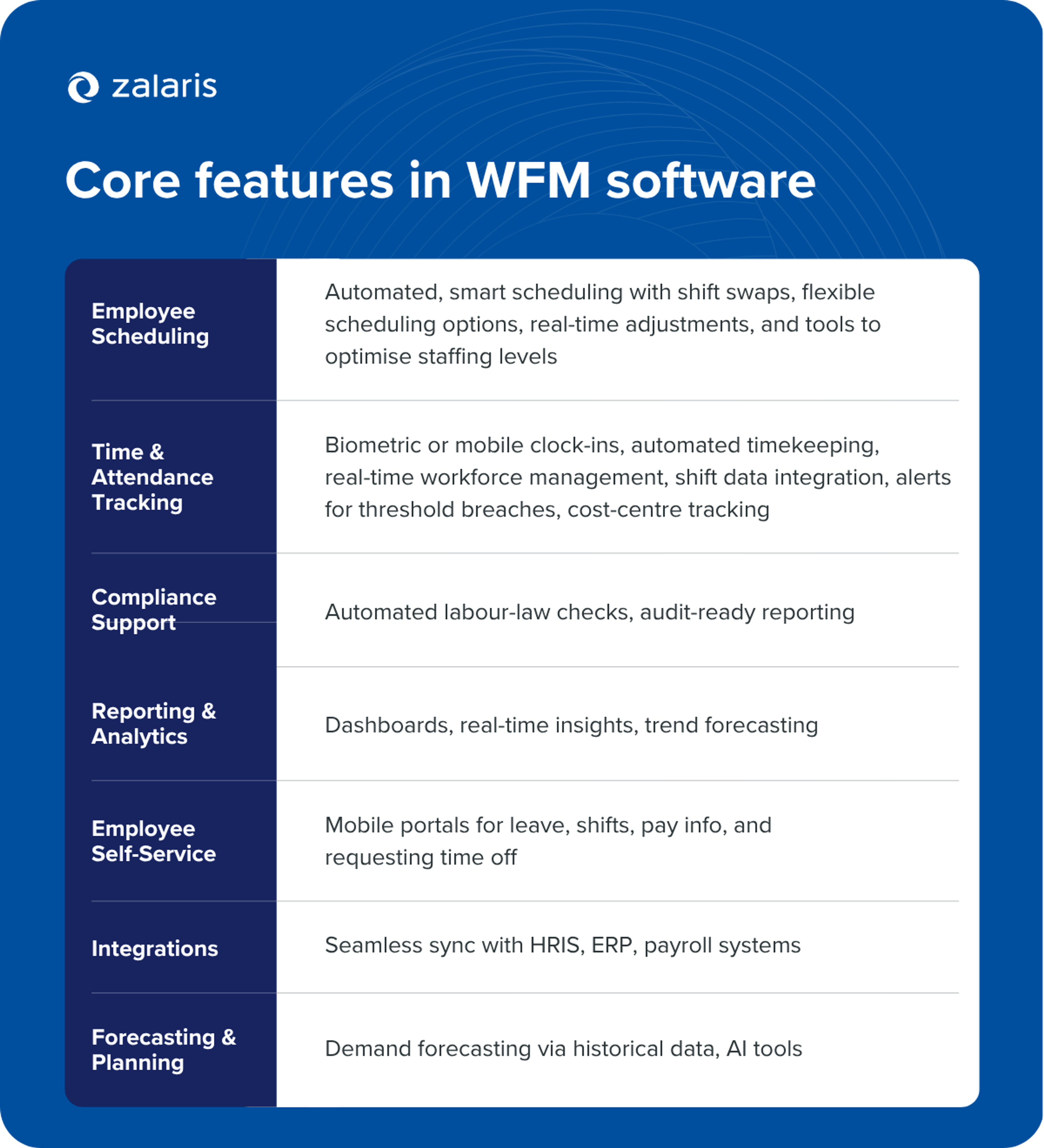WFM explained: What is workforce management?
Explore how modern workforce management (WFM) solutions enable HR leaders to turn challenges into opportunities for greater efficiency, resilience, and strategic leadership.
Liam Clark

HR leaders face mounting pressure to deliver accuracy, agility, and compliance while balancing employee satisfaction. HR teams now play a strategic role in navigating workforce challenges, driving talent acquisition, and supporting digital transformation. However, outdated and fragmented process workflows often create hidden costs, compliance risks, and disengagement. The need for streamlined processes is critical to reduce administrative burdens and improve operational efficiency.
Workforce management is no longer an administrative back-office function. It is a strategic function that aligns people, processes, and technology with business objectives. From forecasting demand to ensuring compliance and enabling employee self-service, WFM empowers organisations to operate with greater control and agility. In this article, we’ll unpack its evolution, key components fundamental to effective workforce management, benefits, challenges, and real-world implementation examples, helping HR and IT leaders make informed, evidence-based decisions.
The evolution of workforce management
Workforce management has undergone a rapid evolution in just two decades. The first wave was HR automation, where core processes such as scheduling, time recording, and absence management were centralised to reduce manual effort. The second wave was integration, as organisations connected HR, payroll, and ERP systems to create a single source of workforce data, improving accuracy and compliance, while centralising and securing workforce management data. Integrating workforce management software into the broader tech stack is crucial for seamless operation, ensuring compatibility and efficient data flow across all systems.
Today, the third wave is defined by intelligence. Modern WFM solutions employ real-time demand signals and AI-driven forecasting to optimise staffing with precision, factoring in skills, compliance, and employee preferences. The use of real time data enables immediate, accurate insights for better decision-making and process automation. Intraday re-scheduling and scenario modelling allow organisations to adapt quickly to disruptions. At the same time, predictive analytics highlight risks such as skills shortages or compliance breaches before they occur.
Workforce management today has become a strategic function for HR leaders, crucial for aligning workforce capacity with business performance. It balances cost control and compliance with employee wellbeing, supporting fair scheduling, flexible work patterns, and proactive absence management.

Core functions of modern workforce management
Modern workforce management is built around several essential workforce management functions that collectively support effective workforce planning, deployment, and oversight:
- Forecasting and planning: Estimating workforce demand based on historical data, seasonality, and operational requirements.
- Scheduling: Assigning shifts and roles by considering employee skills, availability, and compliance requirements, while optimising employee schedules to match business needs.
- Time and attendance: Recording and tracking time, managing attendance data, monitoring hours worked, absences, and leave to ensure accuracy and streamline payroll processes.
- Leave management: Integrating employee leave data with payroll and other HR functions, providing self-service options and automation to improve visibility, accuracy, and administrative efficiency.
- Performance and productivity tracking: Collecting and reviewing data on employee performance and output, which can be used to guide development, coaching, and engagement initiatives.
- Compliance and reporting: Ensuring adherence to labour laws, internal policies, and regulatory requirements, while integrating HR activities and HR processes to improve organisational efficiency and align with business goals.
These components give organisations both visibility and agility, enabling leaders to make workforce decisions that drive efficiency, resilience, and employee trust.
Mobile workforce management: Adapting to a global workforce
The shift towards remote work and geographically dispersed teams has made mobile workforce management a critical component of effective workforce management strategies. As businesses adapt to new ways of working, the ability to manage employees who are not tied to a single location is more important than ever. Mobile workforce management solutions empower companies to oversee their distributed workforce with the same precision and efficiency as traditional, on-site teams.
With mobile workforce management, businesses can streamline employee scheduling, ensuring that the right employees are assigned to the right shifts, regardless of where they are working. Real-time attendance tracking and time tracking features allow managers to monitor hours worked, breaks, and absences from any location, reducing the risk of errors and ensuring compliance with labour laws. These solutions also enable employees to clock in and out, request time off, and view their schedules directly from their mobile devices, enhancing flexibility and supporting better work-life balance.
The impact of workforce management on organisational performance
Workforce management connects workforce capacity to business performance, supporting business goals and business needs. Beyond administrative tasks, it helps a company protect margins, manage risk, improve the company's productivity, enhance employee experience, improve employee engagement, and provides HR leaders with the data to anticipate skills gaps, model scenarios, and inform strategy.
Organisational and strategic benefits of effective workforce management
A strategically designed workforce management (WFM) system delivers measurable outcomes that create value and benefit both the organisation and its people through effective workforce management:
Improved financial performance: By aligning staffing with demand, effective WFM ensures the right number of people are in the right place at the right time, reducing overtime, idle labour, and reliance on temporary workers. This protects margins, leads to improved workforce productivity, and frees resources for strategic initiatives.
Enhanced operational agility: Organisational capacity can adjust rapidly to changing business demands, maintain consistent service levels, and meet stakeholder expectations, even during peak periods or unexpected staff shortages, thanks to optimised WFM practices that help maintain a productive workforce.
Lower risk and stronger compliance: Well-structured WFM frameworks proactively enforce labour laws and internal policies, reducing legal and reputational risk while lowering administrative burden.
Greater employee engagement and retention: Fair, transparent, and preference-aware scheduling through comprehensive WFM empowers employees, boosts satisfaction, reduces burnout, and helps attract and retain top talent.
Better strategic decision-making: Proactively managed WFM gives leaders and managers insight into workforce strengths, gaps, and capabilities. This understanding allows HR and organisational leaders to plan ahead, anticipate future needs, and make informed decisions that drive long-term growth.
Common challenges for organisations without effective WFM
Organisations that lack a robust WFM system often face significant obstacles. Common challenges include:
- Complex scheduling and capacity planning: Fluctuating business cycles make it difficult to balance coverage and availability without gaps, burnout, or excess labour costs. Ensuring the right number of employees working at optimal times is essential to enhance performance and control labour costs.
- Time and attendance tracking: Manual or fragmented systems introduce payroll errors, compliance risks, and planning delays digital workforce management scheduling tools prevent. Automation helps reduce human errors and is crucial for reducing errors in time recording and payroll adjustments.
- Retention and performance management: Low engagement, unclear performance metrics, and limited development opportunities can lead to employee turnover, creating considerable costs and operational challenges for organisations.
- Compliance with evolving regulations: Labour laws, data protection, and union agreements are difficult to track without automated support, raising risk of fines and reputational damage.
- Skills shortages and agility: Organisations struggle to maintain agility amid rapid shifts, digital transformation, and multigenerational teams. These pressures are compounded by growing talent shortages: nearly 70% of UK firms reported difficulties hiring skilled workers in 2023, particularly in high-skill sectors such as digital and software, manufacturing, medicine and life sciences, teaching, and construction.
- Data and analytics complexity: Generating actionable insights requires integrated, high-quality data; without it, decisions remain reactive rather than strategic. Streamlined process management is needed to ensure data supports effective workforce planning and compliance.
- Manual or fragmented systems: Relying on outdated methods increases the risk of human errors and makes it difficult to automate repetitive tasks such as data entry and scheduling, reducing overall efficiency and accuracy.
The advantage of leveraging WFM software and tools
According to the Market Data Forecast report on the European Workforce Management Software (WMS) market, 60% of businesses in the UK have upgraded their WMS in 2024. This leaves 40% of organisations still relying on legacy systems. While these can function in isolation, most of them lack integration, scalability, and strategic insight, resulting in inefficiency, inconsistent data, and reactive decision-making. Selecting the right WFM solution is crucial for ensuring scalability, robust analytics, and adaptability to future workforce challenges.
Workforce management software centralises scheduling, attendance, compliance, and reporting in one digital hub. Automated features, such as shift swaps, time-off approvals, and overtime alerts, reduce administrative burden, while payroll and HRIS integration enhances accuracy.

Choosing the right workforce management solution
Workforce management solutions are a strategic investment with measurable impact. But only when chosen systematically using clear criteria and objective case evidence of benefits.
HR and IT teams should develop a decision matrix that aligns with their priorities, such as cost, support, or scalability, against available options. Peer networks and independent research provide insights that can then be communicated transparently to all stakeholders.
Here’s a practical checklist for choosing a workforce management system:
- Define business objectives and requirements: List the critical challenges you want the solution to address (e.g., schedule optimisation, compliance, absence management). Set measurable goals (cost savings, productivity, turnover reduction). Ensure the solution aligns with your business needs to support operational goals and growth.
- Engage key stakeholders: Involve HR, payroll, IT, finance, and end-users to gather comprehensive needs.
- Evaluate essential features: Investigate if your chosen WFM software integrates with other systems like core HR and payroll and the features it offers (including analytics and user experience).
- Assess the vendor’s reputation, support, compliance, and security: Review track record, client references, industry expertise, and support services offered. Ensure robust data privacy features, support for regional labour laws, and secure data handling.
- Request a pilot or demo. Assess the software’s ease of use and ability to deliver stated benefits through a live demonstration or pilot phase.
- Consider the total cost of implementation: Understand deployment (licence, implementation) and operational expenses. Avoid only focusing on the lowest upfront price.
- Integration with existing systems: Ensure the process is compatible with your current HR, payroll, and other business systems for seamless operation.
Workforce management as a driver of HR success
Effective workforce management equips organisations to plan smarter, engage employees, and maintain compliance while reducing costs and inefficiencies. By replacing fragmented processes with automated WFM tools, businesses gain real-time workforce insights, error-free payroll, and agile scheduling. These capabilities not only improve operational efficiency but also enhance employee experience and organisational resilience.
Zalaris delivers integrated, cloud-based workforce management solutions across the globe. From payroll outsourcing to HR analytics and ongoing support, our solutions ensure efficiency, compliance, and scalability. Get in touch with our team today.
Frequently Asked Questions (FAQ):
1. What is workforce management?
Workforce management involves the processes and tools used by organisations to plan, schedule, and monitor their employees effectively. It helps businesses optimise staffing levels, ensure compliance with labour laws, and improve overall productivity.
2. How does workforce management software benefit businesses?
Workforce management software streamlines employee scheduling, time tracking, and attendance management. It reduces labour costs, minimises human errors, and enhances employee engagement by offering self-service options and flexible scheduling.
3. Why is mobile workforce management important?
Mobile workforce management enables companies to manage remote and distributed staff efficiently. It allows employees to clock in, request time off, and view schedules from mobile devices, supporting better work life balance and operational efficiency.
4. How can workforce management improve compliance?
Effective workforce management ensures adherence to labour laws and company policies by automating compliance checks and generating audit-ready reports. This reduces legal risks and helps maintain a fair and transparent workplace.

Liam Clark
HCM Consultant
Liam is an HCM Consultant of Zalaris UK&I, with a technical and functional background of SAP Products. His current focus is on SuccessFactors Employee Central and Recruitment Modules. Before joining Zalaris at the start of 2021, he worked as a SAP HCM and Payroll Specialist within the UK Public Sector.
Table of Contents
- The evolution of workforce management
- Core functions of modern workforce management
- Mobile workforce management: Adapting to a global workforce
- The impact of workforce management on organisational performance
- Organisational and strategic benefits of effective workforce management
- Common challenges for organisations without effective WFM
- The advantage of leveraging WFM software and tools
- Choosing the right workforce management solution
- Workforce management as a driver of HR success
- Frequently Asked Questions (FAQ):

